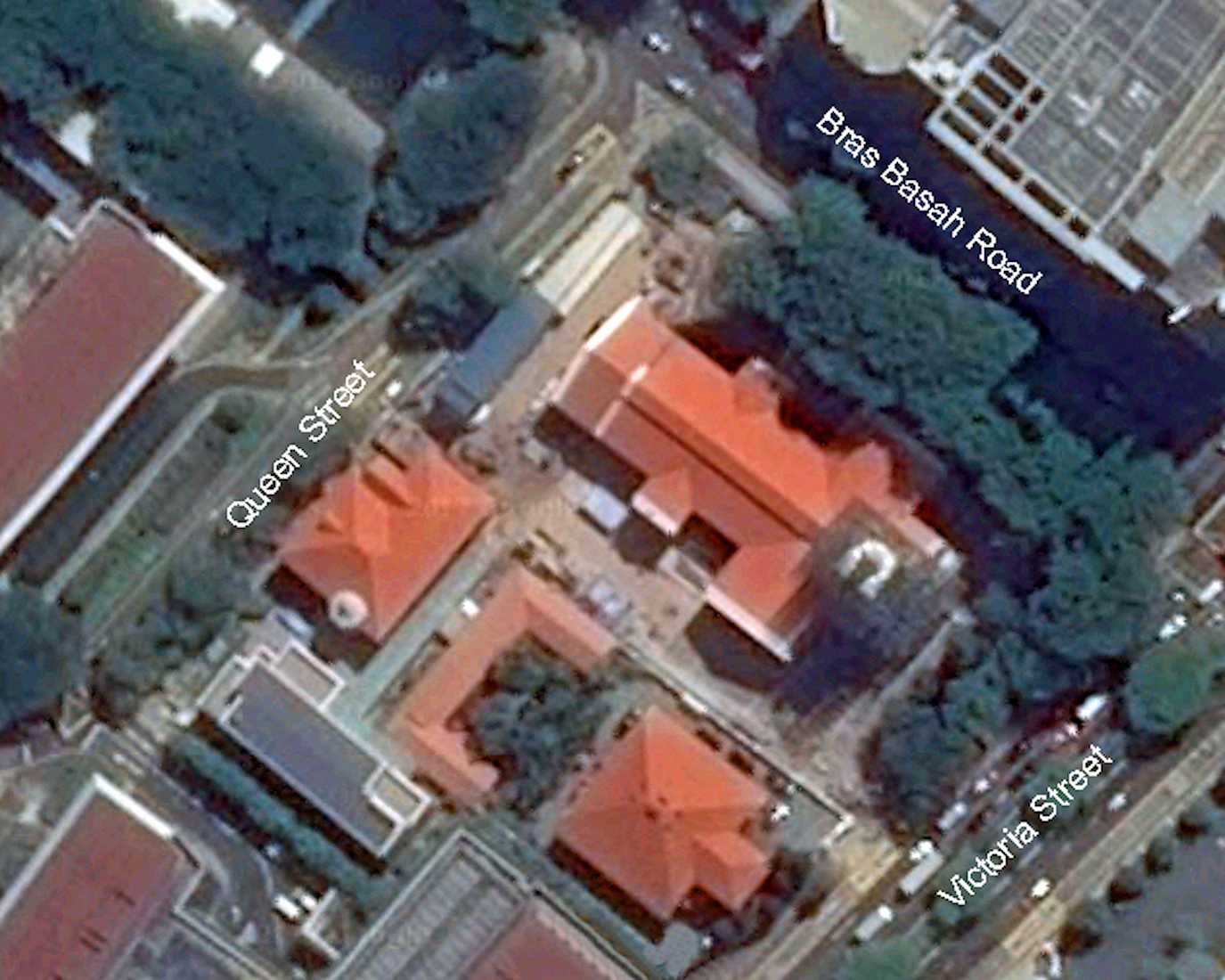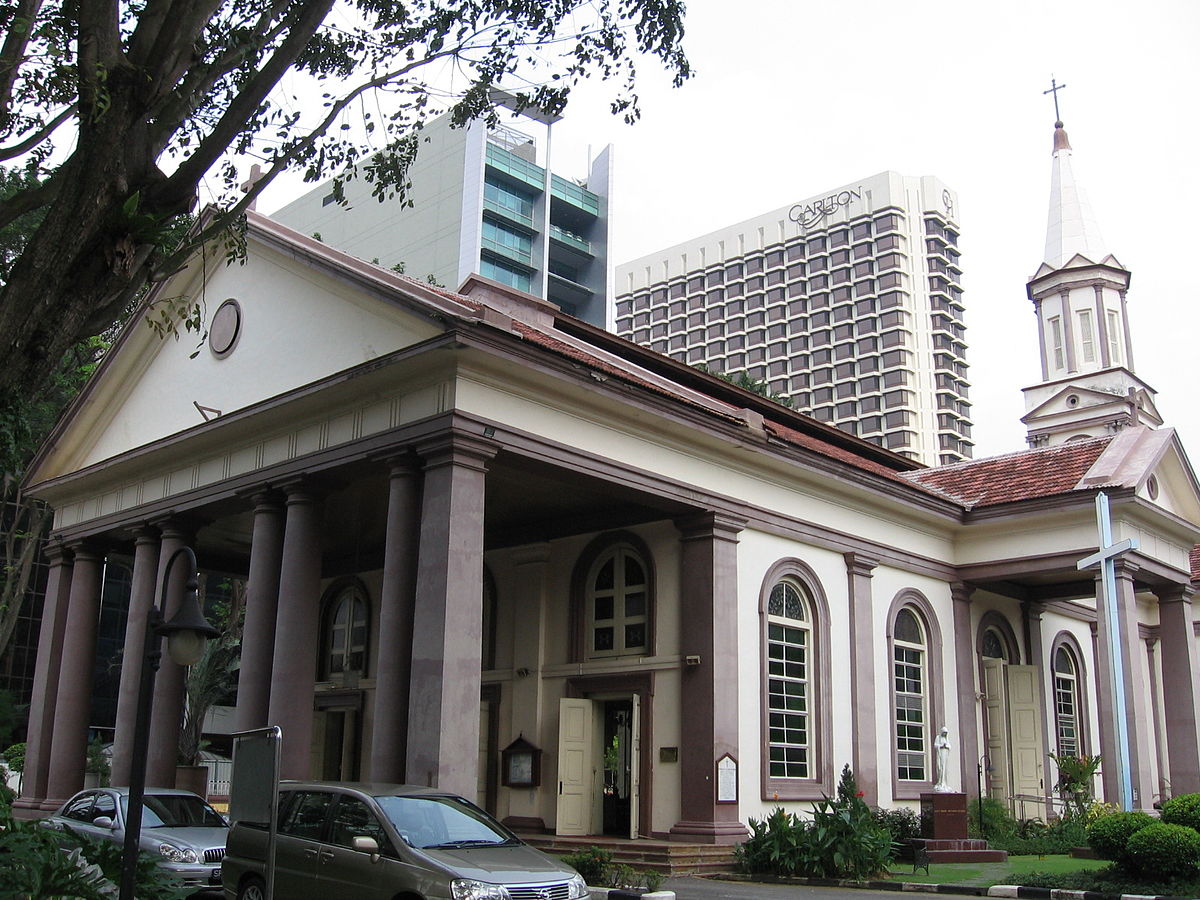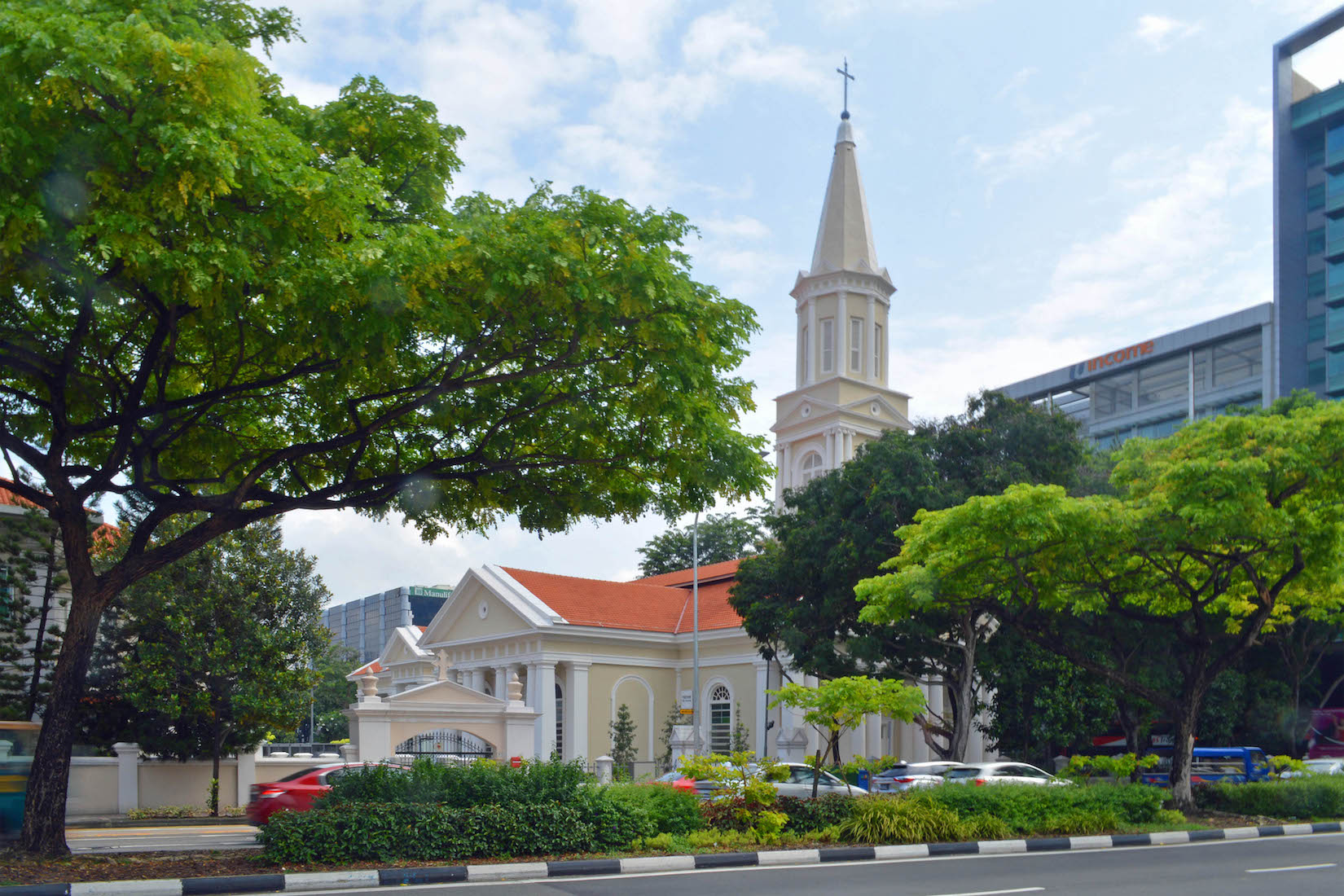CATHEDRAL OF THE GOOD SHEPHERD
SINGAPORE CATHOLIC
PAUL SCOTT

SATELLITE VIEW
The Cathedral of the Good Shepherd is aligned with the surrounding streets in a roughly northwest – southeast direction. The sanctuary is at the Victoria Street end. We shall use liturgucal directions, and label this as East (capital E). The Cathedral is in the shape of a simple Latin cross with a tower and spire at the East end, and two small transepts out over the nave side doors.
This is the first cathedral I have photographed for which I have been unable to find a plan!

Our plan will be to walk around the Cathedral in a clockwise direction starting near the Northwest corner. In fact we circumnavigate it twice: first at a distance, and then more closely, exploring the little labelled gardens along the way, as well as the interesting underground Perpetual Adoration Chapel. We shall then enter the Cathedral by the West door, and work our way towards the sanctaury and the impressive high altar.
A history of the Cathedral is given below. However, if you want to begin your tour of the Cathedral immediately, tap / click on START . You can also access intermediate points in the tour by a tap / click on the following links:
11. To the Perpetual Adoration Chapel
NOTE ON MAGNIFYING IMAGES
With this website format the images are large enough for most purposes. If there is a need for greater magnification of an image, go to the identical photo on
https://www.flickr.com/photos/paulscottinfo/albums
and use Command - + (Mac) or Windows - + (Windows).
The photograph at left comes from Wikipedia, and shows the Cathedral before its latest renovation.
HISTORY
[Wikipedia]
The Cathedral of the Good Shepherd is the oldest Roman Catholic church in Singapore. It is located in the Museum Planning Area within the Civic District.
Bounded by the parallel Queen and Victoria Streets, and Bras Basah Road, the Cathedral sits within shaded grounds. Much of its architecture is reminiscent of two famous London churches namely St Paul’s, Covent Garden and St Martin-in-the-Fields.
The Cathedral of the Good Shepherd is the Cathedral church of the Roman Catholic Archdiocese of Singapore and the seat of its archbishop. It is the final resting place of Bishop Edouard Gasnier, the first bishop of the revived Diocese of Malacca and aptly houses the relics of Saint Laurent-Marie-Joseph Imbert, to whom the Cathedral owes its name.
History
Chapel
In the beginning, the Roman Catholic community in Singapore attended Mass at the house of Denis Lesley McSwiney. In 1832, construction began on the first permanent Roman Catholic house of worship in Singapore. Financed through public subscriptions, the chapel, completed by 1833, was a small wood and attap (palm) structure measuring 60 feet long by 30 feet wide that had cost about 700 Spanish dollars to build. The chapel, with neither tower nor spire, was on the site of the former Saint Joseph’s Institution buildings, now occupied by the Singapore Art Museum, and allotted by the Resident Councillor, George Bonham to Father Jean-Baptiste Boucho, a French missionary who had come from Penang. It was located in European Town, an area marked out in Sir Stamford Raffles’ 1822 town plan as a residential area for Europeans, Eurasians and wealthy Asians.
Church of the Good Shepherd
By the end of the 1830s, the chapel had become too small. Bishop Jean-Paul-Hilaire-Michel Courvezy, Vicar Apostolic of Siam, considered extending the chapel but was persuaded by the newly arrived Parish Priest, Father Jean-Marie Beurel, to keep the site for a school and to build a church elsewhere. The Governor, George Bonham, offered a site on the slopes of Government Hill, now Fort Canning, but this was turned down by the Bishop. The second offer of land was a site bounded by Victoria Street, Bras Basah Road and Queen Street and was conveniently located near the proposed school, later to be Saint Joseph’s Institution. This site was accepted.
In 1840, a subscription drive was started whereby Queen Marie-Amélie Thérèse of France and the Archbishop of Manila contributed 4,000 francs and about 3,000 Spanish dollars respectively. The Government Surveyor, John Turnbull Thomson, had prepared the first design for the church, but it was considered too expensive to build and difficult to maintain. The design that was accepted was that by Denis Lesley McSwiney, a design that was said to owe much to George Drumgoole Coleman’s original Saint Andrew’s Church. On 18 June 1843, the cornerstone for the church was blessed by Bishop Jean-Paul-Hilaire-Michel Courvezy, Vicar Apostolic of Malacca-Singapore, and was laid by John Connolly, a merchant. In 1847, a steeple was added. It was designed by Charles Andrew Dyce who modelled it on John Turnbull Thomson’s design for the steeple added to the Saint Andrew’s Church.
On 6 June 1847, the completed church was blessed and opened by Father Jean-Marie Beurel. The total payments amounted to 18,355.22 Spanish dollars.
Cathedral of the Good Shepherd
In 1888, the church was elevated to the status of Cathedral when the Diocese of Malacca was revived. Bishop Edouard Gasnier, the first bishop of the revived Diocese of Malacca died in 1896 and is interred in the Cathedral. His successor, Bishop René-Michel-Marie Fée, was the first bishop consecrated in the Cathedral in 1896. Although the church was elevated to the status of cathedral in 1888, the consecration ceremony was performed only on 14 February 1897 when the Cathedral had finally repaid its debts incurred from the extension of the nave in 1888. Improvements were gradually made to the Cathedral. The dwarf wall, gate pillars, and ornamental cast iron gates and railings around the grounds were completed in 1908. The Gallery Organ was in place by 1912, while electric lighting came in 1913 and electric fans in 1914.
During the invasion of Singapore during World War II, the Cathedral was used as an emergency hospital.
The Cathedral of the Good Shepherd was gazetted a national monument on 28 June 1973.
Rationale for name
Saint Laurent-Marie-Joseph Imbert, who died a martyr in Korea, was probably the first priest to visit Singapore. The dedication of the church to the Good Shepherd stems from the note written by Saint Laurent-Marie-Joseph Imbert to his fellow missionaries, Saints Pierre-Philibert Maubant and Jacques-Honoré Chastan, asking them to surrender to the Korean authorities to save their flocks from extermination during a period of Christian persecution in Korea. He had written, In desperate circumstances, the good shepherd lays down his life for his sheep. They did and the three of them were beheaded on 21 September 1839. News of this and their martyrdom reached Singapore at the time when an appropriate name was being considered for the church. The choice was made at the suggestion of Bishop Jean-Baptiste Boucho.
Significant dates
• 1833 – First permanent Roman Catholic house of worship in Singapore blessed and opened.
• 1843 – Foundation stone laid by John Connolly on the Feast of Corpus Christi.
• 1847 – Church of the Good Shepherd blessed and opened by Father Jean-Marie Beurel.
• 1859 – Original Parochial House (now Archbishop’s House) completed.
• 1888 – Elevated to the status of Cathedral when the Diocese of Malacca was revived.
• 1888 – Extension of the nave at the west end completed.
• 1897 – Consecration of the Cathedral by Bishop René-Michel-Marie Fée.
• 1909 – Dwarf wall, gate pillars, and ornamental cast iron gates and railings around the grounds completed.
• 1911 – Second Parochial House (now Cathedral Rectory) designed by Father Charles-Benedict Nain completed.
• 1912 – Gallery Organ dedicated by Bishop Marie-Luc-Alphonse-Emile Barillon.
• 1913 - 1914 – Electric lights and fans introduced.
• 1942 – Used as an emergency hospital during the invasion of Singapore.
• 1973 – Gazetted a national monument.
• 1983 – Sanctuary remodelled.
• 1992 – Widening of Victoria Street causing the boundary of the grounds to be moved back.
• 1994 – Choir Organ built by Robert Navaratnam.
• 1997 - 1999 – Major restoration.
• 2013 - 2016 – Second major restoration.
• 2017 – Rededicated on 14 February, 120 years after the original consecration in 1897.
Time capsule
In early 2016, beneath the Cathedral’s foundation stone, a shoebox-sized time capsule from June 18, 1843 was discovered and was found to include a prayer booklet and newspapers, and international coins. The capsule is thought to have been buried by French Catholic missionary priests and other founding communities of Singapore.
https://en. wikipedia. org/wiki/Cathedral_of_the_Good_Shepherd



